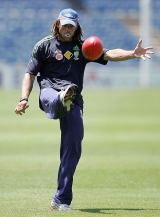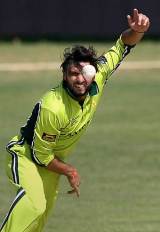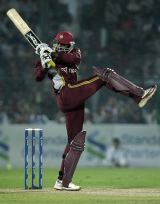Dazzling all round
Men who can bat and bowl to international standard are the most sought-after accessory of all
Andrew Miller
10-Mar-2007
They are the holy grail of cricket selection. Men who can bat and bowl
to international standard are the most sought-after accessory of all.
The list of all-time great allrounders can more or less be counted on
the fingers of two hands, but at one-day international level, ten tidy
overs allied to a half-century equals a potentially matchwinning
performance. And that's where these key figures come in.
|
|

|
In Andrew Symonds and Shane Watson, Australia have,
potentially, two of the most pivotal performers of all. Symonds is a
one-day superstar, a batsman of breathtaking power whose heavy-limbed
medium-pace and offspin is tailormade for those sluggish middle overs.
Recently though, he suffered a torn bicep which leaves his
participation and effectiveness in some doubt, and in his absence,
it'll be Watson, a more classical alternative, who'll have to step up.
He is better suited to the opener's role, while his seam bowling is
brisk without being express, and ever so slightly unproven. Oh, and
talking of Australian allrounders, it would be rude to exclude Adam
Gilchrist, the wicketkeeper-batsman.
At the 1992 World Cup, England had - at a pinch - eight or nine
genuine one-day allrounders in their starting eleven. This time they
have just two, although one of them is a leviathan among his peers.
Andrew Flintoff was the most economical seamer at the 2003 World Cup,
and that was before his game had matured to the extent it now has.
Injury permitting, he has it in him to rule this competition,
providing genuine pace and relentless accuracy with the ball, and
game-breaking strokeplay with the bat. Toiling alongside him will be
Paul Collingwood, the star of the show in the recent CB Series. In the
form of his life with the bat, it could be his nagging medium pace
that comes to the fore on some sluggish Caribbean tracks.
If Flintoff's coming-of-age got Englishmen a bit excited, then the
same and more could be said of India's young superstar, Irfan
Pathan. Still only 22 years old, his derring-do at the top of both the
batting and bowling orders has drawn comparison with the great Kapil
Dev, although fears were raised about his form in South Africa before
Christmas when he was sent home to cool off in domestic cricket. As a
prodigious swinger of the new ball, all of India hopes that the break
will have done him good come the start of their campaign against
Bangladesh next Saturday.
|
|

|
Though his current form is unproven, at least Pathan is in the squad.
Pakistan, on the other hand, have lost so many of their star
players, including their most potent allround talent, Abdul Razzaq, to
an untimely knee injury. Step forward Shahid Afridi, one of the most
natural talents the game of cricket has ever seen. His ballistic
batting has to be seen to be believed - his most recent onslaught was
an absurdly belligerent 77 not out from 35 balls at Durban. But it is
his under-rated wrist-spin that is arguably his most consistent
weapon. Brisk, accurate and fizzing, they leap disconcertingly from a
good length, and will undoubtedly be a big asset as the tournament
progresses.
Talking of under-rated spinners, here's another. Sri Lanka's
old stager, Sanath Jayasuriya, is embarking on his fifth World Cup,
and at the age of 37, is arguably a more rounded cricketer than ever
before. His pinch-hitting batting remains as explosive as it was in
1996, but his bowling has undergone a revival, seeing as he is now Sri
Lanka's No. 1 spinning foil to the undisputed master, Muttiah
Muralitharan. Sri Lankan cricketers have long been
jacks-of-all-trades, but at the other end of the age spectrum is their
next big allround prospect, Farvez Maharoof - only 22 years old, but
brisk enough to have taken 6 for 14 in the recent Champions Trophy
against West Indies.
South Africa is another nation that grows allrounders as if on
trees, and the present crop is an enviable one, to say the least. Men
such as Andrew Hall and Justin Kemp would grace any side, but in Shaun
Pollock and Jacques Kallis, South Africa have two men who have been at
the top of their game for a decade and more. In Pollock's case, he is
back where he belongs after an 18-month slump that left several
pundits casting nervous glances towards the retirement home. He has
been revived by responsibility, pushed up the batting order to win two
Tests against India and Pakistan, and bowling his wicket-to-wicket
seamers with the waspishness of old. Kallis, meanwhile, recently
enjoyed a typically prolific home season, scoring 119 not out and
taking 3 for 3 in one remarkable win against India at Durban.
New Zealanders are used to being belittled by Australians, so
when Jacob Oram was recently dismissed as a "poor man's Chris Cairns"
he took it upon himself to shove those words straight back down the
nearest available Green-and-Gold throat. Standing at six-foot-plenty,
Oram bowls his lively medium-pacers from a cloud-snaggingly high arm,
and when batting he turns the midwicket boundary into his personal
fiefdom with a firm swing of his strong bottom hand. He walloped the
Aussies for 101 not out from 72 balls at Perth in the CB Series,
before a broken finger ruled him out of the subsequent triumph in the
Chappell-Hadlee Trophy. He vowed to have it amputated if needs be, but
his 88 against Bangladesh last week showed he'll be able to battle
through the pain.
|
|

|
Another tall left-handed strokeplayer with a high bowling action is
set to be a star for the host nation, West Indies. Chris Gayle
has inherited Curtly Ambrose's role as the Daddy Cool of the Caribbean
team, but like Ambrose he has a competitive streak that belies his
languid demeanour. He was the star player at the last ICC event, the
Champions Trophy in India before Christmas, where he thumped three
centuries including a matchwinning 133 not out in the semi-final
against South Africa, and took eight wickets with his deceptively
innocuous offbreaks. Scarcely less effective was his team-mate, Dwayne
Bravo, the possessor of the best slower ball in the game today, who
also chimed in with the first of what should be many ODI hundreds. He
has it in him to be the star of the tournament.
Bangladesh's two-wicket win against New Zealand last week was
ample proof that they will be no pushover at this World Cup. Their
recent success has been based on a more traditional division of
labour, with batsmen such as Habibul Bashar and Mohammad Ashraful
making the runs, and bowlers such as Mashrafe Mortaza and Syed Rasel
taking the wickets, but one player with a foot in both camps is their
veteran left-armer, Mohammad Rafique. Predominantly a spinner, he does
however have an eye for the ball that is the preserve of few, and an
axeman's delight in wild and woolly strokeplay. On Bangladesh's last
trip to the Caribbean, this approach was good enough to score him an
astonishing Test century from No. 9. Don't be surprised to see more of
the same.
The best of the rest is Holland's Ryan ten Doeschate.
One of the rising stars in the Essex side that won the Pro40 League in
2006, his huge hitting and skiddy bowling has been making several
headlines in recent times. In the ICC Intercontinental Cup he smashed
an unbeaten 259 and finished with the extraordinary average of 228.66
including four successive centuries, while Holland's warm-up against
India last week was notable for his impressive haul of 5 for 57. "Ryan
is a world-class performer when he's playing well," said his coach,
Ian Pont. "He's a real contender as one of the stars of the
tournament."
Click here
to post your views on this topic
Chris GayleCurtly AmbroseShaun PollockJacques KallisJacob OramAbdul RazzaqSanath JayasuriyaShahid AfridiKapil DevIrfan PathanSyed RaselAndrew FlintoffPaul CollingwoodMohammad RafiqueRyan ten DoeschateShane WatsonAndrew SymondsAdam GilchristBangladeshNetherlandsZimbabweSri LankaPakistanIndiaNew ZealandWest IndiesSouth AfricaAustraliaEnglandICC World Cup
Andrew Miller is UK editor of Cricinfo